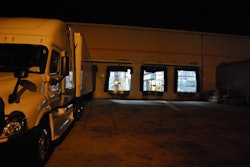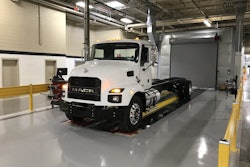Shop managers get pulled in a million different directions because of all the responsibilities they have. Things like inventory management, preventive maintenance, customer interactions, parts ordering, training, tools, software, designing repair protocols, spec’ing vehicles, management re-inspections, managing suppliers, bosses, and on and on. Keeping up with daily service operations can be overwhelming even under the best of conditions. As a result, it is difficult for them to stay focused on the big picture: total cost of ownership
 Joe Puff is vice president of truck technology and maintenance for NationaLease.
Joe Puff is vice president of truck technology and maintenance for NationaLease.Having to balance all of these day-to-day responsibilities can mean that a quality “root cause analysis” program gets overlooked. This involves getting to the true cause of a problem and the payback of future maintenance efficiency can be huge. Best handled by a manager, the analysis can also be delegated to a journeyman technician.
Do you think you have a good root cause analysis program? Here are a few things a shop manager can do to test the quality of their operation.
Look at the tires
Go out to your scrap tire pile and identify every tire failure. You will likely find tires scrapped due to misalignment, mechanical repairs, tires ran so long that it damaged the casing, tires run while underinflated, flat spots, tires damaged by road hazards, failed prior tire repairs, etc.
For every tire that was not scrapped due to old age, go to your maintenance files to determine if corrective actions were taken to prevent a recurrence of the same problem.
For example, look at:
- Repair orders (RO) for alignment, suspension, or wheel end repair if the scrap tire was caused by a mechanical failure.
- PM intervals to see if the tire was run too long, which damaged the casing, or if there was a change in the tread depth removal policy. The pre-trip inspection process should also be reviewed to determine if drivers are merely pencil whipping the forms or if they are doing a thorough job on their pre-trips.
- Credit ROs issued by your tire re-capper if the failure fell under warranty cap or casing coverage.
- Documented training or coaching memos if the scrap tire was related to poor judgment or poor repair quality.
- Supervisor documentation for not following up on an emergency or temporary repair.
It is one thing to find out why the tires failed but you accomplish nothing unless action is taken to prevent the problems from recurring.
Review urgent repairs
Examine 30 days of urgent non-scheduled repairs. Every urgent or unscheduled repair should be investigated to find the root cause for the failure. Ask yourself why it failed and why it was allowed to fail. The answers to the “why” questions will tell you a great deal about what is going on with your vehicles.
A good example is a no-start road call. When the tech gets to the truck and determines the battery is dead, they replace the battery and test the alternator output. When the alternator tests good, and the battery is blamed as the root cause and the vehicle is put back in service. Six months later there is another identical dead battery event. Six months after that, the same thing.
You must decide if you are going to investigate the root cause after the first failure, the second, or the fifth?
At some point, someone in your organization needs to look at the number of battery discharges and the depth of those discharges, the amount of current draw and for how long that current draw lasted, the recharge time or driving time between stops, voltage drop tests, etc.
Unless there is indisputable root cause evidence explaining the reason for the failure, it is only a guess — sometimes an educated guess and sometimes a wild guess. If the root cause determines a premature battery failure then you must ask yourself if you are spec’ing and buying the right batteries. On the other hand, if the failed battery is six years old it is reasonable to assume the battery lived its full life and only a short root cause investigation is warranted.
Look at your specs
You may be surprised at how many maintenance expenses are controllable when you build and spec a new vehicle. Did you perform a good operational analysis and spec the right components for the job? Did you choose the right tire design? Did you set the most effective ECM parameters for the job, etc.?
Putting together a solid plan
So, where do you start when implementing a root cause analysis program? For every emergency repair, pull all recent DVIRs, the last two PM sheets and the maintenance file. Ask yourself if the potential failure could have been identified during an inspection or PM service. Was a DVIR or pre-trip inspection ignored or not properly addressed? Was an emergency repair not followed up on? Identify every possible point where the problem could have been identified and prevented failure to determine where the weak spots are and then develop a plan to eliminate those weaknesses and cut down on-road failures and recurring problems.
Ask yourself how a failure occurred and how you can keep this from recurring. If a tech made a mistake, ask yourself if the right tech was assigned to the task. Did you provide the proper training and proper amount of time to complete the task? Were the right tools available or did the tech just not care?
I encourage shop managers to use this process as a learning and coaching tool and not to discipline employees unless the problems continue to recur. You need a coaching process for techs, shop managers, purchasing managers and spec’ing managers, sales personnel, etc. If the primary function of your root cause analysis is discipline, you will likely see a defensive culture develop and it will be extremely hard to uncover the real root cause for other failures.
Today there are too many tires and other components replaced in order to get the vehicle back in service without any action being taken to prevent recurrences of the same problem.
One final thought: you can’t fix what you don’t know about.
Joe Puff is the vice president of truck technology and maintenance for NationaLease, and has more than 35 years of experience in complex sales and fleet operations, including extensive experience in commercial vehicle maintenance. Joe is responsible for advising NationaLease members and the National Account team of new truck technology, industry trends, and maintenance best practices.












